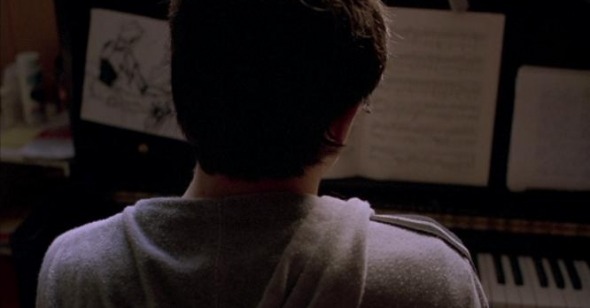This Time, It's Personal
Matthew Plouffe on Elephant
Upon returning from Cannes with a Palme dâOr in tow, Elephant was not infrequently assailed stateside as incomplete and inchoate, excoriated for all the things it of which it wasnât enough: it wasnât enough of an answer, it wasnât enough of an insight, and frankly, it wasnât a film of enough substance. Chiding critics named Gus Van Santâs portrait of a school shooting irresponsible, inert, and third in a trilogy of hollow formal exercises lead by the soporific tag-team, Psycho (1998) and Gerry (2002). Even the prestige of a Palme dâOr was near-nullified under the weight of two more highly publicized harbingers of doubt: 1) U.S. critics controversially opined that the French were honoring another timely film about gun-crazy Americans as a subversive slap in the face (Bowling for Columbine won a 2002 Jury Prize and Palme nomination), and 2) Cannes 2003, was unanimously proclaimed âWorst Ever.â Chalk âem up. Maybe it wasnât even a valid winner, and even if it was, maybe that didnât mean a thing.
But one question still remains to be answered: What is Elephant? In a key scene, dp Harris Savides places his camera at the center of a roundtable discussion regarding whether or not itâs possible to tell if someone is gay, simply by looking. A collection of teens decry the idea as the typical high school seminar, like, proceeds. The camera pans slowly on point from student to student, and speciously telling voices hit our ears often before the matching adolescent appears on-screen. Utilizing the simplest of cinematic means, the conversation quickly turns self-reflexive; discerning audience members canât help but hear homosexuality in a young manâs argument against that very idea. We can tell heâs gay even before we see him. And then the face rolls into frame, and that mental image weâd so confidently constructed crumbles away, second-guessing ensues, and an audience reticently reneges, âWell, maybe not. I canât really tell.â And with a final self-aggrandizing air, âProbably, though. He will be.â
Where do we point fingers? How do we identify which 16-year-old is gay or, say, which is planning murder in his (or her) high school? Letâs take a second look. On our behalf, Savidesâs interrogating lens leers from behind, fluidly creeps around the side and stares head-on, examining the awkward gait, the dismissive hair flip, pores that define the daily drama of adolescence in languorous long takes. A pre-mortem autopsy of surfaces in the hallways of a scholastic slaughterhouse, through a jaw-droppingly deft reconstruction of an American institution, Elephant grants its audience the chance to do what weâve all wanted so badly since Columbine: to see todayâs high school from the inside out, to pin the tail on the troubled teen we know we couldâve identified with the same confidence backing our crude criminalization of video games, governmental jingoism, and firearm access. To those satisfied with the reductive reasoning of Michael Moore, Van Sant impels that second look and suddenly, it becomes so clearly unclear. Finally. Is it the video games and the spitballs? Or is it the drunken Dads, the locker room ridicule? Could it really even be that simple? Bowling for Columbine comparisons are inevitable, and Elephant seems a subdued amalgam of the formerâs two high points: A walk through the halls of Columbine High spliced with actual footage of the shootings, and Marilyn Mansonâs refreshingly erudite statement that faced with the students, he would do what nobody else did and listen to them.
In a Film Comment interview with Amy Taubin, Van Sant remarks, âYou know, for five blind men the elephant is like a wall to one, a rope to another, a tree to another, a snake to the fourth one⌠Itâs an unanswerable question.â If Elephant is anything, itâs an explosive round of those questions fired at every soggy answer weâve festooned with toothy arrogant resolve. Itâs 2003 and blame has been dispensed. Fingers have been pointed. America seems pretty happy with its answers. Then out of nowhere, the unwanted pseudo-arthouse stray arrives interested in school shootings. Try this one on for size: Could we have seen it coming if weâd just looked further, deeper? Post Twin Towers a quiet examination of high school sears the skin of self-reflection and cuts right to the core of our fundamentally flawed reasoning processes, to shameful truths exhumed only when a Dylan Klebold or Osama bin Laden decides to shake things up.
However, it is in those enigmatic and hotly debated shots of the sky that Van Sant seems to pose the ultimate elephant of a question, the one lurking in the dark recesses of this gloriously elegiac film. The shots warrant, I believe, all of the âmaybesâ theyâve inspired. Maybe they express the arbitrary qualities of the massacre. Maybe they remind us of the divine presence who obviously didnât come to work that day. Or maybe that gaze upward is ours. For me, that cloudy sky brings one devastating image to mind: that of someone dropping to their knees, staring up to the heavens, and posing that unanswerable question weâve all asked in the last few tragedy-ridden years, âWhy?â Itâs often great art that couples its vision with a courageous reminder that truly ineffable answers will forever remain just that, a burden of responsibility which both compels and justifies the artistâs search in the first place.
